Welcome
to the Island of Dominica -
LukeTravels.com™
Main Page
 Dominica Photo Gallery
Dominica Photo Gallery
 About the Island of Dominica
About the Island of Dominica
 Journey to the Boiling Lake
Journey to the Boiling Lake
 How to get to Dominica
How to get to Dominica
 Map of the Island
Map of the Island
 Airfare & Hotel Info
Airfare & Hotel Info
 Contact
Us
Contact
Us  Advertise
Here
Advertise
Here  Neighboring Island:
Guadeloupe
Neighboring Island:
Guadeloupe
 Neighboring
Island: Saint Lucia
Neighboring
Island: Saint Lucia
 LukeTravels.com Home
Page
LukeTravels.com Home
Page
DOMINICA -
ABOUT THE ISLAND
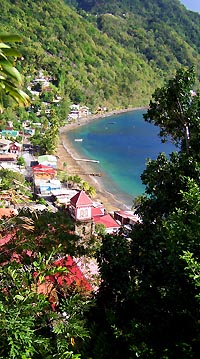 |
 |
Not to be confused with
the Dominican Republic, Dominica sprawls over a rocky terrain in the
Lesser Antilles. Known for its stunning topography, Dominica has one
of the world's last ocean rain forests, a lake covered with purple
hyacinths, and so many species of trees that one of them is named
"no-name."
Here is an island of boiling lakes and
mountain cascades, of desolate, lava-ravaged landscapes, of forests
dense with rain-forest bromeliads. There is so much mist from the
morning and evening showers that rainbows are as predictable as the
sun.
The Commonwealth of Dominica,
commonly known as Dominica, is an island nation in the Caribbean Sea.
In Latin, its name means "Sunday", which was the day on which it was
discovered by Christopher Columbus.
Dominica's pre-Columbian name was
Wai'tu kubuli, which means "Tall is her body". |
The indigenous people of the island, the
Caribs, have a territory similar to the Indian reserves of North America.
However, its official language is English because of its history as a British
colony, territory, and state though a French creole is spoken by many,
especially people of older generations. The demonym or adjective of this
country is "Dominican" in English, same as that for the Dominican Republic but
unlike the Dominican Republic, in which the stress is on the first "i", the
stress is on the second "i".¹
Dominica is not for fainthearted or
out-of-shape visitors. Divers best know how to exploit a real surf-and-turf
vacation -- most take a 2-hour tank dive in the morning, followed by some
equally daunting land excursion in the afternoon. Come to Dominica and expect
yourself to be taxed to the max -- you may need another Caribbean isle on
which to recover.
Morne Trois Pitons National Park: The park's misty,
rain-forested mountainsides and deep valleys are filled with waterfalls and lakes. Paved
roads get you right up to the park, and short walks will take you to two of its most
popular features: Trafalgar Falls and the Emerald Pool. Swimming is allowed. If you're in
good physical shape and not afraid to get muddy, the 3-hour hike to steamy Boiling Lake is
a real adventure.
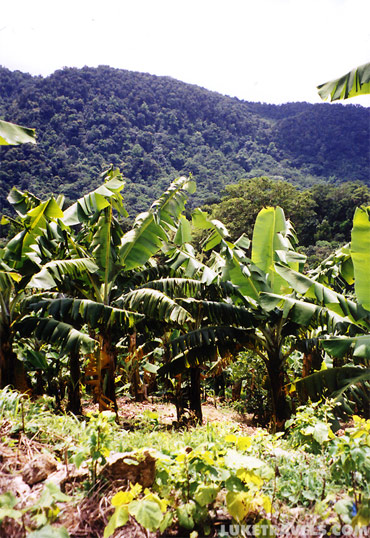
Photo Copyright © LukeTravels.com |
 |
  |
Cabrits National Park: Cannons and stone ruins are all that remain of historic Fort
Shirley, alternately controlled by the French and the British. Glorious views can be had
of Portsmouth, the island's second-largest town, and Prince Rupert Bay, with its
black-sand beaches and where such seafaring luminaries as Christopher Columbus, Sir
Francis Drake, and Captain John Smith dropped anchor. It's a short hike up to the fort and
museum from the new cruise ship dock, which provides restrooms, a snack bar, and a crafts
store.
Carib Territory: Approximately 3,400 people of Carib descent live in this 3,700-acre
reserve on the island's wave-battered east coast. This is the Caribbean's largest
remaining community of Caribs. In Bataka, Salybia, Sinecou, and other hamlets along the
main east coast road, tourists can watch artisans at work and purchase crafts from
roadside stands. Intricately woven grass baskets, hats, and mats are Carib specialties. If
you can't make it to the Territory, stop in at the Kalinago Centre on King George Street
in Roseau. This Carib-sanctioned center displays historical photographs and sells
traditional Carib arts and crafts.
Wildlife-watching: November through March is prime whale-watching season, although sperm
whales may be sighted year-round. Dive operators will take you out to look for orca,
sperm, pilot, and false killer whales, as well as large pods of spotted and spinner
dolphins. The Northern Forest Reserve, accessible by road from the village of Dublanc, is
the place to look for two rare parrots: the sisserou, Dominica's national bird, and the
jaco. A mile-long walk takes you to a viewing platform. Hummingbirds and butterflies are
abundant throughout the island. Keep an eye out underfoot for 10-foot-long boa
constrictors, giant beetles, and scurrying land crabs!
DOMINICA -
ISLAND FACTS
Dominica, island republic in the West Indies, lying in the Caribbean Sea, approximately midway between the islands of Guadeloupe (on the north) and Martinique (on the south). One of the Windward Islands, Dominica is about 47 km (about 29 mi) long and has an area of 750 sq km (289 sq mi).
Seasons: The driest season, January through June, is the
best time to visit Dominica. The rains are heaviest from August through October, which is
also hurricane season. At all times of the year the precipitation is higher in the
mountains than on the coast. Temperatures vary little from winter to summer, with highs
between 80° and 90° F (27° and 32° C).
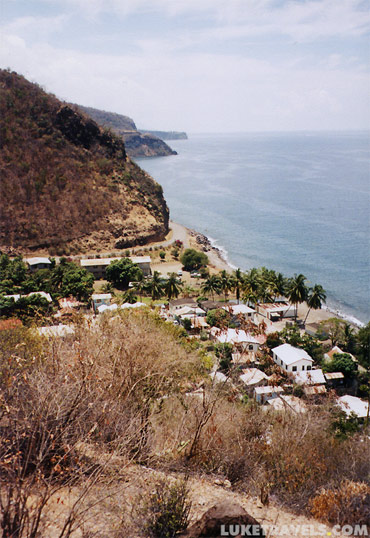
Photo Copyright © LukeTravels.com |
 |
  |
Flights: American Eagle has flights that originate in San Juan, Puerto Rico. The regional
carrier, LIAT, as well as British Airways and Air France, all have connections to Dominica
from neighboring islands such as Antigua, Guadeloupe, St. Martin and Barbados. Of the two
airports on the island, Canefield is very close to the capital city of Roseau, while
Melville Hall is an hour's drive away.
Ships: Cruise ships pull into the new docks at Roseau (as does the high-speed interisland
ferry) and Cabrits National Park.
Getting around: Taxis are reliable and reasonable; roads, while often twisty and slow, are
paved and suitable for rental cars. When renting a vehicle, consider a 4-wheel
drive car or truck for off-road driving. A public minibus system is also handy for getting around.
DOMINICA -
LAND AND THE PEOPLE
Dominica is volcanic in origin and has a mountainous terrain, with several peaks rising above 1220 m (about 4000 ft); the highest point is Morne Diablotins (1447 m/4747 ft). The island has a tropical climate with an average annual temperature of about 27° C (about 80° F). The annual rainfall is considerable, ranging from about 1780 mm (about 70 in) on the coast to more than three times that figure in the mountains. The island has many small
un-navigable rivers; Boiling Lake, from which sulfurous gases frequently arise, is located in the south. Luxuriant forests cover the mountains.

|
Dominica has a total population (2008 estimate) of 72,500 or exactly
71,727, according to 2003 cencus. More than 90 percent of the inhabitants are black, descendants of slaves brought from Africa in the 18th century. A small number of Carib also live on the island. English is the official language, but a French patois is widely spoken. Roman Catholicism is the predominant religion. Roseau (population, 1987 estimate, 22,000) is the capital and chief port.
Click here for detailed map of Dominica |
|
|
DOMINICA -
ECONOMY
Dominica's economic situation is among
the most challenging of all the Eastern Caribbean states. However,
Dominica's economy grew by 3.5% in 2005 and 4.0% in 2006, following a
decade of poor performance. The country nearly had a financial crisis in
2003 and 2004. Growth in 2006 was attributed to gains in tourism,
construction, offshore and other services, and some sub-sectors of the
banana industry. The International Monetary Fund (IMF) recently praised
the Government of Dominica for its successful macroeconomic reforms. The
IMF also pointed out remaining challenges, including further reductions
in public debt, increased financial sector regulation, and market
diversification.
Bananas and other agriculture dominate Dominica's economy, and nearly
one-third of the labor force works in agriculture. This sector, however,
is highly vulnerable to weather conditions and to external events
affecting commodity prices. In 2007, Hurricane Dean caused significant
damage to the agricultural sector as well as the country's
infrastructure, especially roads. In response to reduced European Union
(EU) banana trade preferences, the government has diversified the
agricultural sector by promoting the production of coffee, patchouli,
aloe vera, cut flowers, and exotic fruits such as mangoes, guavas, and
papayas. Dominica has had some success in increasing its manufactured
exports, primarily soap.
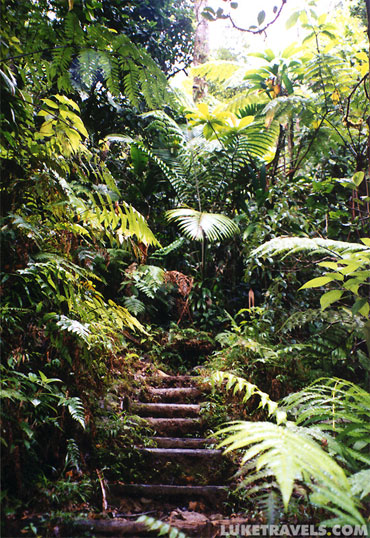
Photo Copyright © LukeTravels.com |
 |
  |
Dominica is mostly volcanic and has few beaches; therefore, tourism has
developed more slowly than on neighboring islands. Nevertheless,
Dominica's high, rugged mountains, rainforests, freshwater lakes, hot
springs, waterfalls, and diving spots make it an attractive eco-tourism
destination. Cruise ship stopovers have increased following the
development of modern docking and waterfront facilities in the capital.
Dominica is a beneficiary of the U.S. Caribbean Basin Initiative that
grants duty-free entry into the United States for many goods. Dominica
also belongs to the predominantly English-speaking Caribbean Community
and Common Market (CARICOM), the CARICOM Single Market and Economy (CSME),
and the Organisation of Eastern Caribbean States (OECS).²
DOMINICA - HISTORY OF THE ISLAND
The Arawaks were guided to
Dominica, and other islands of the Caribbean, by the South Equatorial
Current from the waters of the Orinoco River. These descendants of the
early Tainos were overthrown by the Kalinago tribe of the Caribs. The
Caribs, who settled, what is now Dominica, in the 14th century, called
the island Waitikubuli, which means 'tall is her body'. Christopher
Columbus named the island after the day of the week on which he spotted
it, Sunday, 'Doménica' in Italian, which occured on November 3, 1493.
The indigenous Carib people successfully resisted early European attempts at colonization. In 1632 the French gained a foothold on the island, and they retained parts of it until 1763, when it was assigned to Great Britain by the Treaty of Paris. Under British rule Dominica became part of the Leeward Islands dependency in 1833 and was attached to the Windward Islands group in 1940. In 1967 it became an internally self-governing state associated with the United Kingdom. Dominica attained full independence on November 2, 1978, and subsequently joined the Commonwealth of Nations and the United Nations. The republic's first prime minister was Patrick R. John; he was succeeded by Oliver Seraphin in 1979 and by Mary Eugenia Charles in 1980, 1985, and 1990.
Many of the remaining Carib people live in Dominica's Carib Reserve, a
Territory on Dominica's east coast.²
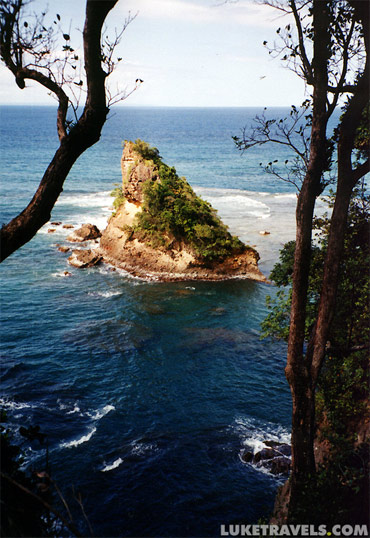
Photo Copyright © LukeTravels.com |
 |
  |
In 1635, France claimed
Dominica. French missionaries became the first European inhabitants of
the island. Carib incursions continued, though, and in 1660, the French
and British signed a neutrality treaty in which both Dominica and St.
Vincent should be abandoned by them and in possession of the Caribs.
Dominica was officially neutral for the next century, but the attraction
of its resources remained; rival expeditions of British and French
foresters were harvesting timber by the start of the 18th century.
Due to Dominica's position between Martinique and Guadeloupe, France
eventually became predominant, and a French settlement was established
and grew. In 1761 a British expedition against Dominica led by Lord
Rollo was successful and the island was conquered. As part of the 1763
Treaty of Paris that ended the Seven Years' War, the island became a
British possession. In 1778, during the American Revolutionary War, the
French mounted a successful invasion with the active cooperation of the
population, which was largely French. The 1783 Treaty of Paris, which
ended the war, returned the island to Britain. French invasions in 1795
and 1805 ended in failure. The 1805 invasion burned much of Roseau to
the ground.
In 1763, the British established a legislative assembly, representing
only the white population. In 1831, reflecting a liberalization of
official British racial attitudes, the Brown Privilege Bill conferred
political and social rights on free nonwhites. Three Blacks were elected
to the legislative assembly the following year. Following the abolition
of slavery, in 1838 Dominica became the only British Caribbean colony to
have a Black-controlled legislature in the 19th century. Most Black
legislators were small holders or merchants who held economic and social
views diametrically opposed to the interests of the small, wealthy
English planter class. Reacting to a perceived threat, the planters
lobbied for more direct British rule.
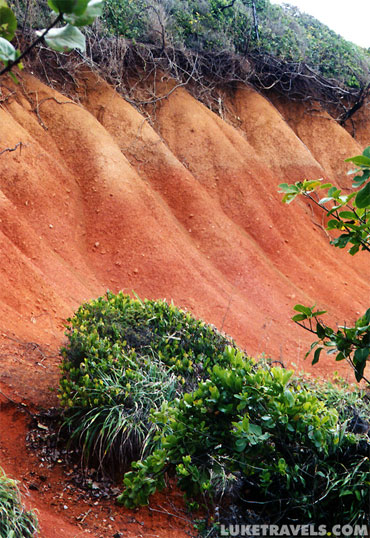
Photo Copyright © LukeTravels.com |
 |
  |
In 1865, after much
agitation and tension, the colonial office replaced the elective
assembly with one composed of one-half elected members and one-half
appointed. The elected legislators were outmaneuvered on numerous
occasions by planters allied with colonial administrators. In 1871,
Dominica became part of the Leeward Island Federation. The power of the
Black population progressively eroded. Crown Colony government was
re-established in 1896.
Following World War I, an upsurge of political consciousness throughout
the Caribbean led to the formation of the representative government
association. Marshaling public frustration with the lack of a voice in
the governing of Dominica, this group won one-third of the popularly
elected seats of the legislative assembly in 1924 and one-half in 1936.
Shortly thereafter, Dominica was transferred from the Leeward Island
Administration and was governed as part of the Windwards until 1958,
when it joined the short-lived West Indies Federation.
In 1961, a Dominica Labor Party government led by Edward Oliver LeBlanc
was elected. After the federation dissolved, Dominica became an
associated state of the United Kingdom on February 27, 1967 and formally
took responsibility for its internal affairs.²
1. Special thanks to Wikipedia and its
authors.
2. Special thanks to Wikipedia and its authors.
3. Copyright ©
1993-2008 Encarta (Microsoft Corp). All Rights Reserved.
Map Copyright © 2001-2008 Expedia Maps. All Rights Reserved.



